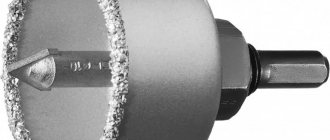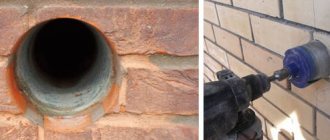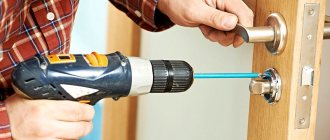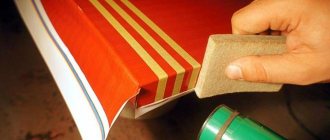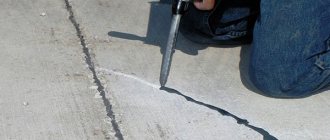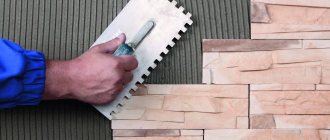Beton-House.com
Website about concrete: construction, characteristics, design. We combine the experience of professionals and private craftsmen in one place
How to drill a hole in concrete
Quite often it is necessary to drill holes in concrete during construction work and its completion. And doing it yourself is a convenient and useful skill. This will allow you to easily hang shelves on the wall, hang your favorite paintings, attach lamps and perform many other operations.
Drilling holes in concrete is not too difficult, but the correct selection of tools and adherence to several rules will save effort and time when performing the work. This will be discussed in the article.
- Drilling a hole
Necessary tool
The need to drill into load-bearing concrete walls arises regularly (for example, when repairing or installing electrical wiring, plumbing or furniture, such as shelves or an air conditioner), but this is not easy to do - such walls are much stronger.
A hammer drill is best suited for working with concrete. It is quite powerful and has a crushing function that breaks particularly strong pieces of the wall. The kit includes a set of drills of different diameters.
In some cases, you can use a simple drill to drill a hole in concrete. It is worth using if:
- You need to make some holes.
- The depth of the hole does not exceed 1.5 cm.
- You have to drill foam concrete - when using a hammer drill it crumbles.
In other words, a drill can be used if the amount of work is small and the holes themselves are small. But experts note that using a conventional drill will make drilling labor-intensive. Not just any drill will do - it must have an impact mode and pobedite bits.
Drill modes - drilling, drilling+impact, hammer drill Source rykinekruki.ru
You can also purchase a hammer drill - a more expensive but more powerful model.
The list of things to use to drill into a concrete wall also includes a screwdriver. But the model must be powerful enough and have durable attachments, and the concrete must be light.
Reconstruction of walls after relocation of sockets
When moving sockets, excess recesses must be sealed with gypsum or cement mortar. The technology for carrying out such work largely depends on the depth of the hole. If it exceeds 5 cm, then you will definitely need a piece of foam plastic or a stone of appropriate dimensions.
Step-by-step instruction:
- Clear the space of dust and small debris.
- Lightly moisten the walls of the hole.
- Drive 3-4 self-tapping screws along the edges to hold the filler.
- Fill the bottom of the hole with the selected solution.
- Place a suitable sized pebble or foam material inside.
- Fill the hole with the prepared composition. If cracks form, the procedure should be repeated again.
- After the surface has dried, apply a thin layer of putty.
- Apply fine-grained sandpaper.
Compliance with the correct sequence of restoration work guarantees a perfectly level base.
The procedure for sealing a hole from an outlet is very simple to perform; even an untrained person can easily cope with it. Source folksland.net
Selection of nozzles
The correct choice of nozzles is extremely important. For work, special nozzles of increased strength are required.
The following types are used:
- Toothed bits for impact drilling.
- Diamond bits. Their edges have special cutouts and are coated with diamond chips or corundum. They are distinguished by increased strength (they even cut reinforcement) and accuracy: the surface of the hole is perfectly smooth. They work without shock.
Diamond-coated crown Source yunimag.ru
- KS-crowns. Their edges are coated with larger diamond particles.
When working with a drill, a punch may be required. This is a special durable pin that is used for crumbling concrete. Instead, you can use a pin, core, or even an old drill.
See also: Catalog of companies that specialize in the design and reconstruction of houses of any complexity
To drill holes for polypropylene pipes twenty (diameter = 21 mm) I need:
1. a drill for a hammer drill with a diameter of at least 22 mm (or better yet 25, remember that polypropylene expands for hot water supply?), and a length of at least 300 mm, this is the thickness of the plaster and concrete block. It was not possible to drill the sleeper with a drill. you'll go nuts..; 2. a wood drill, of the same diameter, at least 650 mm long, here I take into account the thickness of the conventionally drilled plaster and block, plus the “air cushion” and plus the sleeper itself; 3. a drill for a rotary hammer with a diameter of 12, a length of more than 730, here is the full thickness of the wall (do we remember that you can only drill on one side? Yes, and the horseradish holes towards each other will coincide with two, and if you measure thoroughly, then the slope is any will be different).
Drilling a wall at once with a large-diameter drill is very labor-intensive and time-consuming; it is much easier and faster to drill a thin one, and then expand the hole with a larger one along the guide. I use this method up to several passes with different drills in increasing increments, depending on the ultimately required diameter. The “old-fashioned” method is very effective, you save a lot of physical effort, and what is important in my case is time - the work at first glance is “the cat cried”, all it takes is to remove two tubes, BUT the wall...
So, I went to the store, not familiar with the prices for the tool I need? The price tag for hammer drills, along with the length and increase in diameter, grows not just proportionally, but catastrophically, however, the same applies to screw drills. Here are some screenshots with price tags:
Normal, right? And this is here in the provinces! I wonder what the cost is in regional and capital cities?
An alternative to a long screw drill is a feather drill, the condition of suitability is that you buy an extension cord, one is missing, you take two, luckily connecting them together is as easy as shelling pears. That's exactly what I did, I already had one extension cord.
As a result, I received the required tool at a reasonable price, but you can’t explain to the customer that the tool is expensive; to put it mildly, he’s not interested. Visibility is only two half-inch tubes installed, but how you did it is your problem. The point is that an identical order, as I wrote above, will probably go through in the next five-year period, and the instrument will lie idle.
Step by step how I drilled:
1. from the side of the attached room, using a hammer drill with a 12 mm drill, I drilled through the plaster and block; 2. widened the hole with a 25 mm drill; 3. drilled the sleeper with a 25 mm feather drill; 4. then, again installing a long thin drill, I drilled through the plaster at the exit; 5. with a 25 mm drill, on the other hand, I expanded the diameter towards.
It took about 30 minutes to do everything. Next, soldering the pipes is a different story. This is how I handled my next order in an accessible way; if any of you benefit from my experience, then it’s not in vain that I clicked on the keys.
Conclusion:
And one more thing: with feather drills, the option of gradually increasing the diameter does not work, you drill immediately with a wide feather, the price for them is a pittance in comparison with drills, and I have never seen wooden walls of great thickness.
Two useful additions, naturally based on personal experience:
First:
When installing pipes, in addition to water supply, I also install sewerage if necessary. It’s no secret that the diameter of the pipes here is larger, from 40 to 150 millimeters; I don’t have a drilling rig with diamond bits, so I fulfill orders using the same hammer drill. I proceed as follows: I mark a circle of the required diameter on the wall, drill holes along its perimeter with a thin long drill, then, using the same principle that I highlighted above, I expand the diameter of each hole to the maximum available in the arsenal. Then, replacing the drill with a spatula and switching the hammer drill mode to chiselling, I get rid of everything unnecessary. So... I agree the work is not pleasant, but this is just one of the disadvantages during installation. It should be borne in mind that this process is relevant for a small wall thickness, say a maximum of 300 millimeters, but for a much larger thickness you present the customer with a fact: ordering a drilling rig is a device, as noted above, using bits with diamond tips. The operation is not cheap, but with all the “breadth” of choice... the customer pays, then we come in with the installation.
Second:
Let’s say you fulfill the first point yourself: you drill a concrete wall, trying to get a hole with a diameter of 140 millimeters, and you have a “surprise” in the form of reinforcement (usually in the walls of panel houses).. You can’t take it with a drill, electric arc welding will help, for lack of, grinder, which is problematic to use, access is difficult, you have to puff, creating access... in short, I don’t advise you to bother. Exit: cut by welding or gas cutting. There's no such thing? Find it! As in that saying: “It’s better to lose a day, but then fly in five minutes!”
Questions, additions: in the comments column, but that’s all for me today, best regards, Andrey.
Tired of looking for information from practitioners? Subscribe (scroll down the page) and the information will find you. Clicking on the social network icon is the best reward from you for me!
Preparation and process
Before drilling into a concrete wall with a conventional drill, you need to inspect the tool, check its serviceability and insert the nozzle completely until it stops.
Then you will need to inspect the wall and check if wires and cables will be touched. If possible, you should also make sure that there is no reinforcement if you are using a non-diamond drill. If there may be reinforcement along the drilling path, it is necessary to prepare a metal drill.
Before you start drilling, you need to protect yourself: wear thick gloves, safety glasses, and insert earplugs or headphones.
Drilling a hole
First you need to mark the location and select the depth. Modern models usually have special limiters. If they are missing, you can put a mark on the nozzle.
A few examples will help you better understand how deep you need to drill: for a picture or a light shelf, 2.5 cm deep is enough.
Drilling with special attachments Source minemegashop.ru
When installing the dowel, the hole should be several millimeters longer. When the dowel is inserted, dust will form, which will take up extra space.
A hole is drilled in a brick or concrete wall in several steps:
- Having chosen a place and made a mark, attach the tip of the nozzle and turn on medium speed without turning on the impact mode.
- After passing a few millimeters, you need to increase the speed and turn on the shock mode. This will allow you to continue drilling smoothly without deviating due to strong vibrations.
- Every 10-15 minutes you need to stop and let the engine cool. You can continue only when the tool has completely cooled down.
- If desired, the nozzle can be regularly moistened with water so that the metal does not bend or overheat.
Working with a punch will require more time and labor. The tool itself is necessary when the wall is too hard and the drill cannot cope.
Using a limiter Source mebel-expert.info
What do anchor ties provide in construction?
Concrete floors are laid in buildings and structures on load-bearing walls, starting from the basement and on each floor for the floor and ceiling. After laying and anchoring the slabs, they are monolied, that is, they are filled with cement mortar in the form of a screed and the result is a solid box that is not subject to any shifts or distortions. In essence, this is the answer to the question about the need for anchor connections: the slab will not move across the floors even with a strong push
If you have ever seen with your own eyes or just in photographs a house after an artillery shelling, then you probably noticed that the floors, as a rule, are more intact than the walls, and all this is possible thanks to monolithic connections
It is possible not to use anchoring of floor slabs only when a small one-story building is being erected in a seismologically safe area, but this only applies to slabs in the attic. But in most cases, a good owner will still not build a house, leaving the ceiling without such fasteners, especially since it is inexpensive.
This excerpt shows that the manual is of a recommendatory nature. Source
This may seem strange, but today there are many opponents of anchoring, who claim that houses without such insurance will also stand and will not go anywhere. Perhaps they are given confidence by the fact that in the “Manual for the Design of Residential Buildings” such fasteners are presented in the form of a recommendation, and not a law? But it would not be amiss to note here that, according to statistics, it is recommendations that more often save human lives than laws.
Video description
This video shows how to drill a hole with a hammer drill with a diamond bit:
Diamond drilling is done in 2 ways - dry and wet. In the second case, when drilling, water constantly flows onto the working surface. It cools the drill and reduces noise; dust settles in it. However, if electrical wiring runs nearby or constant access to water is not possible, the dry method is used.
Diamond drilling produces smooth holes Source kas.kz
Work with large diameters
At the beginning of the work, the area where the hole should be formed is outlined. It is important to observe dimensions here. When the hole diameter is 100 mm, then the circle needs to be drawn at approximately 20 mm. This is typical for situations where the drill deviates from the working circle. Even a small shift can damage the surface if this is not taken into account from the very beginning. You need to make sure that the drill goes through the walls. Only in such a situation can you be sure that the hole will be made correctly.
Useful tips
The drilling process is simple, but it requires certain dexterity and skills. It is important to keep the tool level so as not to displace the drill and increase the load.
Some tips will help simplify the work and make the hole in the wall neat:
- You can't skimp on drills. Poor quality attachments break and bend easily.
- You can determine the presence of fittings with a metal detector.
- When installing the dowel, the hole should be several millimeters longer than the fastening. These extra millimeters will be clogged with cement dust when the dowel is inserted.
- If it is necessary to make a through hole, at the end of drilling, when approaching the opposite side, the speed must be reduced. This will help prevent the concrete from chipping.
- When using a low-power drill, it is important to regularly, every 10-15 minutes, stop and cool the motor. This will help prevent damage to the instrument.
- When drilling, it will be dusty, and therefore, before drilling into a concrete wall, it is better to prepare a vacuum cleaner. It is better to use a construction vacuum cleaner, since household models will quickly deteriorate from small crumbs.
When drilling, a lot of dust rises Source waysi.ru
Sometimes the nozzles get stuck in the block. They should not be pulled by force, as they can easily break and leave a piece in the wall forever. You need to disconnect it, attach a smaller nozzle, and drill into the wall nearby.
Checking the presence of electrical wiring
First of all, it is necessary to determine the drilling location. In this case, the main point is not to get into the electrical wiring. According to building law, all wires are located only vertically and horizontally. And if there is a socket in front of you, then its wire runs vertically to the junction box. True, embarrassments do happen. This is when electricians decide to save cable or wire. Therefore, there is a possibility that the wiring is not laid as it should.
As you can see, the wiring is located horizontally and vertically.
In this case, it is recommended to use special devices that detect the presence of metal objects under the concrete or plaster layer. Chinese devices are inexpensive, but they work well.
Briefly about the main thing
To drill a hole in concrete, use a powerful drill or hammer drill.
The bits must be strong enough to penetrate the stone without getting damaged. When working with walls that have reinforcement, you will need a metal nozzle.
Before you start drilling, you need to check whether there are any wires or pipes running inside the wall. It is also advisable to make sure that there is no reinforcement.
The process itself is simple and requires only care and skill. The main thing is not to overheat the tool’s motor and make sure that the drill does not go to the side.
Ratings 0
A few nuances on how to drill a concrete wall
If you need to drill into concrete, a regular drill is only good for a few small holes. For larger volumes, use a hammer drill or impact drill.
The best tools are diamond ones, which are easier to drill if the electric drill does not have an impact mechanism. They are used intermittently to avoid overheating of the drill. Drilling reinforced concrete is an excessive load for the engine, gearbox, bearings; the drill is not designed for such work, so it is used carefully.
Holes in the ceramic material with which walls are often lined can be made with a concrete drill, pressing lightly so as not to split the tile. Wood and plastic do not lend themselves to it, so first they go through it with a drill for the corresponding material.
